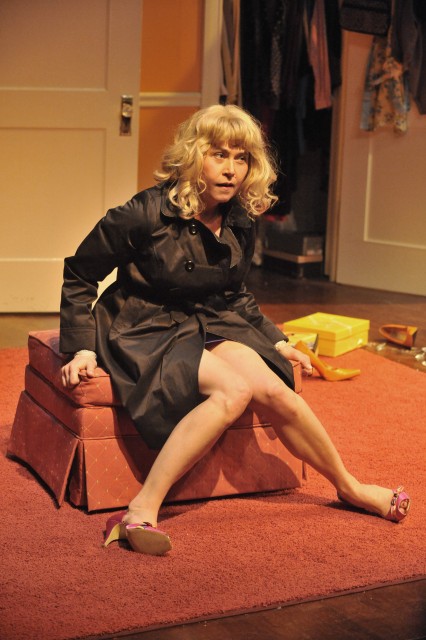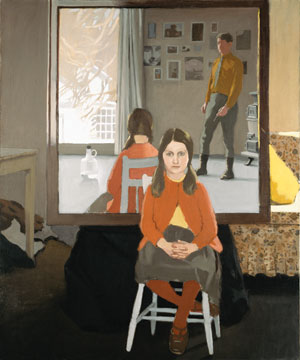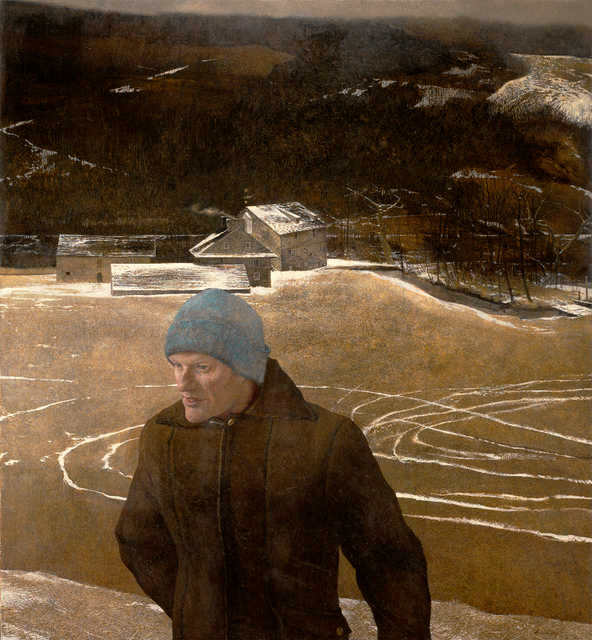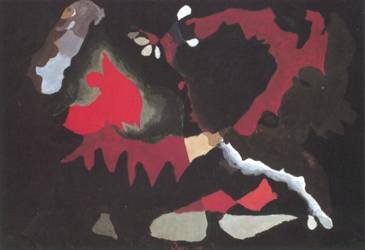Sam Mendes interviews Stephen Sondheim about the genesis of Company:
(This is the latest in a weekly series of arts-related videos that appear in this space each Wednesday.)
Archives for February 2009
TT: Almanac
“Musicals are the only public art form reviewed by ignoramuses. There are very few of them, I can guarantee it, who know anything about music at all.”
Stephen Sondheim, interviewed by Frank Rich (Jan. 18, 2009)
TT: Coast to coast to coast (VII)
JANUARY 29 “Your life sounds like most people’s vacations,” a friend told me not long ago. Yeah, well, maybe, but most people don’t have to spend hours on end writing in hotel rooms. I hate writing on the road, especially when I’m alone, and today was a writing day in the Windy City.
For some reason I find it easier to write in hotel rooms when Mrs. T is with me, though she doesn’t like it any better than I do. “Can’t you come out and play?” she always asks, to which I always reply, “If it weren’t for the work, we wouldn’t be here.” Nor do I have any right to complain, since the shows we see are mostly good and we generally manage to work in various other cultural adventures between curtains and deadlines. Nevertheless, it sure would be nice if I were rich and jobless. Nobody ever believes me when I say so, but I wouldn’t write if I didn’t have to pay the rent.
JANUARY 30 From Chicago to New York, where I picked up a rental car, drove into Manhattan long enough to run by the apartment, pick up the snail mail, and back up my hard drive, after which I headed north to Connecticut and Mrs. T.
JANUARY 31 This was a dark day, as we theater types say, and I spent it at home doing absolutely nothing. To be exact, I slept late, ate three meals, read one-and-one-half Nero Wolfe novels, and watched two old movies on TV.
 FEBRUARY 1 To Lenox, Massachusetts, for the last leg of the Great Theater Marathon of 2009. Shakespeare & Company’s winter show is Theresa Rebeck’s Bad Dates, a one-woman play starring Elizabeth Aspenlieder, a Shakespeare & Co. regular with a knack for comedy who reminds me of the young Lucille Ball, another pretty woman who liked to make demented-looking faces. I wrote about Aspenlieder in last summer’s Wall Street Journal review of The Ladies’ Man:
FEBRUARY 1 To Lenox, Massachusetts, for the last leg of the Great Theater Marathon of 2009. Shakespeare & Company’s winter show is Theresa Rebeck’s Bad Dates, a one-woman play starring Elizabeth Aspenlieder, a Shakespeare & Co. regular with a knack for comedy who reminds me of the young Lucille Ball, another pretty woman who liked to make demented-looking faces. I wrote about Aspenlieder in last summer’s Wall Street Journal review of The Ladies’ Man:
Ms. Aspenlieder is one of the funniest actresses on the East Coast, and I can say no better of her performance as Mme. Suzanne Aubin, a loosely married lady with a widely roving eye, than that it reminded me of my favorite punch line in Joe Orton’s “What the Butler Saw”: “You were born with your legs apart. They’ll send you to the grave in a Y-shaped coffin.” I can’t recall the last time I laughed so hard as I did at the look of glee that lit up her improbably mobile features when she warned the hapless Mr. Croy that “I zink my hass-boont sus-pecttts!“
FEBRUARY 3 That’s all, folks! The marathon is over: Mrs. T and I pack our bags this morning, check out of our beloved Gateways Inn, and return to New York by way of Connecticut. Two shows await us, William H. Macy in Speed-the-Plow and the Irish Repertory Theatre’s revival of Brian Friel’s Aristocrats, followed by Mary Foster Conklin‘s two-night stand at the Metropolitan Room, which conveniently coincides with my fifty-third birthday. No more out-of-town shows until March, and about time, too.
(Last of seven parts)
TT: Almanac
“Our civilization has achieved a distinction of sorts. It will be remembered not for its technology nor even its wars but for its novel ethos. Others have been corrupt, but leave it to us to invent the most undistinguished of corruptions. No orgies, no blood running in the street, no babies thrown off cliffs. No, we’re sentimental people and we horrify easily. True, our moral fiber is rotten. Our national character stinks to high heaven. But we are kinder than ever. No prostitute ever responded with a quicker spasm of sentiment when our hearts are touched. Nor is there anything new about thievery, lewdness, lying, adultery. What is new is that in our time liars and thieves and whores and adulterers wish also to be congratulated and are congratulated by the great public, if their confession is sufficiently psychological or strikes a sufficiently heartfelt and authentic note of sincerity.”
Walker Percy, The Moviegoer
TT: Promises to keep
 Sikeston, the small town in southeast Missouri where I lived as a boy, has only just begun the process of grappling with the devastation wrought by last week’s ice storm. My brother, who spent most of the week helping to maintain order in a community that was cast into darkness by an area-wide power failure, has been checking in with me at regular intervals, telling me stories that would be hard to believe were it not for the news photos that I saw on the Web all week.
Sikeston, the small town in southeast Missouri where I lived as a boy, has only just begun the process of grappling with the devastation wrought by last week’s ice storm. My brother, who spent most of the week helping to maintain order in a community that was cast into darkness by an area-wide power failure, has been checking in with me at regular intervals, telling me stories that would be hard to believe were it not for the news photos that I saw on the Web all week.
The good news–the best news–is that power was restored on Saturday afternoon to the house where I grew up, and my mother returned there shortly thereafter. My brother turned the heat on and restocked her refrigerator. That was the easy part. It will be a lot harder figuring out what to do with whatever is left of the trees in her yard after the ice has melted.
 I fear in particular for the survival of the tree that I described on the last page of the memoir that I wrote in 1991 about growing up in Sikeston:
I fear in particular for the survival of the tree that I described on the last page of the memoir that I wrote in 1991 about growing up in Sikeston:
In the front yard of 713 Hickory Drive is a maple tree that casts a long, cool shadow on summer days. Once it was a slender sapling, held up by wires that led to wooden stakes driven deep in the earth, and I wondered if it would ever grow tall enough for me to climb. It is tall enough now. My niece will soon climb it, and my own unborn children, God willing, will someday climb it too. But for me it will always be the young sapling that stands in front of the house that is my home, in the town that is my home town, in the part of the country where I was born and to which I will always return, frequently and gladly, inevitably and eternally.
Eighteen years have passed since I wrote those words. My niece is in college now, I have no children, and I’ve no idea what will be left of our poor maple tree by the time I manage to get home to Sikeston again. I’m old enough now to have learned that precious few things in life are inevitable, much less eternal. But the house that I wrote about in City Limits is still my home, just as Sikeston is still my home town, and if there’s one thing that’s sure as the turning of the earth, it’s that I’ll be going back there for a visit before too long.
Like the song says, there’s no place like home–even when the weather turns bad.
TT: Coast to coast to coast (VI)
JANUARY 25 “The Journal pays me to fly on airplanes, not to see shows,” I told my niece after we’d seen Kansas City Rep’s production of The Glass Menagerie. I was, of course, exaggerating the least little bit: I’ve seen more than my share of shows for which The Wall Street Journal didn’t pay me nearly enough to sit through. The Glass Menagerie, however, wasn’t one of them, as my review made eminently clear.
 As for my visit to the Nelson-Atkins Museum of Art, it was pure gravy, not least because I got to see my favorite Fairfield Porter painting, “The Mirror,” a masterpiece that has been hung in the museum’s new contemporary-art wing, right where it belongs. I’m no longer allowed to write about Porter in the Journal because I own a half-dozen of his color lithographs (the Journal is fussy about conflicts of interest, both real and hypothetical). I did, however, mention him prominently in a lecture called “Multiple Modernisms: What a Novice Collector Learned from Duncan Phillips” that I delivered four years ago at the Phillips Collection:
As for my visit to the Nelson-Atkins Museum of Art, it was pure gravy, not least because I got to see my favorite Fairfield Porter painting, “The Mirror,” a masterpiece that has been hung in the museum’s new contemporary-art wing, right where it belongs. I’m no longer allowed to write about Porter in the Journal because I own a half-dozen of his color lithographs (the Journal is fussy about conflicts of interest, both real and hypothetical). I did, however, mention him prominently in a lecture called “Multiple Modernisms: What a Novice Collector Learned from Duncan Phillips” that I delivered four years ago at the Phillips Collection:
I own prints by such freely figurative artists as William Bailey, Nell Blaine, Jane Freilicher, Wolf Kahn, Alex Katz, Fairfield Porter, and Neil Welliver, all of whom are highly compatible with the spirit of the Phillips, as well as an etching by Richard Diebenkorn, whose debt to the Phillips Collection was not unlike my own. To round out the whole, I acquired a pair of prints by Pierre Bonnard and Edouard Vuillard, the quintessential Phillips Collection painters, both of whom had a far-reaching influence on those American modernists who were (so to speak) of but not in the New York School. In 1938, around the time that his more precocious contemporaries were grappling with the problem of abstraction, Fairfield Porter went to an exhibition of paintings by Bonnard and Vuillard. He looked around and said to himself, “Why does one think of doing anything else when it is so natural to do this?” It’s a question Duncan Phillips might well have asked himself, too.
 Somebody at the Nelson, by the way, is very smart, for “The Mirror” has been hung side by side with Andrew Wyeth’s “Battleground,” and the pairing of the two canvases speaks volumes about both artists. I wish I’d seen them together prior to writing my Wyeth column for the Journal.
Somebody at the Nelson, by the way, is very smart, for “The Mirror” has been hung side by side with Andrew Wyeth’s “Battleground,” and the pairing of the two canvases speaks volumes about both artists. I wish I’d seen them together prior to writing my Wyeth column for the Journal.
JANUARY 26 People really are nicer here. Everyone I met at Kansas City International Airport–even the guard who waved me through the metal detector–went well out of his or her way to be friendly and helpful. I hated to say goodbye, but Chicago and Our Girl awaited, and two hours later I was checking into my downtown hotel for a four-night stay in the Windy City, where the traffic is heavy and the weather appalling.
 I flew north to see two plays, Chicago Shakespeare’s Macbeth and Shattered Globe Theatre’s The Little Foxes. In between I wrote and filed a drama column, visited the Art Institute of Chicago, hung out with Our Girl and her friends, and ate a meal with Barbara Gaines, the artistic director of Chicago Shakespeare, whose productions I’ve been covering once or twice a year since I started reviewing regional theater for the Journal in 2004. I would have liked to work in another play or two, but my February calendar is so full that I wouldn’t have had space to write about them in the Journal, and the other show at the top of my list, the Goodman Theatre’s revival of Desire Under the Elms, is headed for Broadway in any case. Too many plays, not enough time! Ah, well, I’ll be back in the spring….
I flew north to see two plays, Chicago Shakespeare’s Macbeth and Shattered Globe Theatre’s The Little Foxes. In between I wrote and filed a drama column, visited the Art Institute of Chicago, hung out with Our Girl and her friends, and ate a meal with Barbara Gaines, the artistic director of Chicago Shakespeare, whose productions I’ve been covering once or twice a year since I started reviewing regional theater for the Journal in 2004. I would have liked to work in another play or two, but my February calendar is so full that I wouldn’t have had space to write about them in the Journal, and the other show at the top of my list, the Goodman Theatre’s revival of Desire Under the Elms, is headed for Broadway in any case. Too many plays, not enough time! Ah, well, I’ll be back in the spring….
JANUARY 27 Eric Gibson, my editor at The Wall Street Journal, called to tell me of the death of John Updike. “What city are you in?” he asked. I went blank. “Wait a minute,” I said, then looked out the window and saw ice in the river eighteen floors below me. “Chicago,” I replied.
I checked my e-mail and found a message from Paul Moravec, my collaborator on The Letter. Says Paul: “I’m told we’re in the new Frommer’s Santa Fe guide.” Say I: “Good God, man, buy a copy!” Instead I searched the text via Amazon, and sure enough, The Letter is on pages 6 and 154. Ubiquity, thy name is us….
 No shows or deadlines today, so I spent the afternoon at the Art Institute, communing with some much-loved paintings that hadn’t been hanging when I brought Mrs. T here last June for her first visit. I sought out and found, among other things, John Twachtman’s Icebound, John Singer Sargent’s Thistles, and Arthur Dove’s “Swing Music (Louis Armstrong),” which I hadn’t seen in the flesh since I started work on Pops: The Life of Louis Armstrong. I described it in Pops as “an explosion of jagged red and silver shapes amid a fathomlessly dark landscape–a precise visual evocation of the effect of an Armstrong solo.” I’ll stand by that.
No shows or deadlines today, so I spent the afternoon at the Art Institute, communing with some much-loved paintings that hadn’t been hanging when I brought Mrs. T here last June for her first visit. I sought out and found, among other things, John Twachtman’s Icebound, John Singer Sargent’s Thistles, and Arthur Dove’s “Swing Music (Louis Armstrong),” which I hadn’t seen in the flesh since I started work on Pops: The Life of Louis Armstrong. I described it in Pops as “an explosion of jagged red and silver shapes amid a fathomlessly dark landscape–a precise visual evocation of the effect of an Armstrong solo.” I’ll stand by that.
I also visited Yousuf Karsh: Regarding Heroes, which was a mistake, though not mine: the Art Institute shouldn’t be giving space to this show, since Karsh, the Canadian portrait photographer, wasn’t a serious artist. His let’s-make-an-icon pictures exist to ratify celebrity, not to illuminate character, and their shadowy sameness grows downright silly after you’ve seen the first dozen or so of them. I’d have to double-check the catalogue to confirm this, but my impression was that not a single one of Karsh’s male subjects is shown smiling.
At dinner afterward I told Our Girl that I’d seen the exhibition. “What was it like?” she asked.
“He’s the Ansel Adams of humans,” I replied.
(To be continued)
TT: Almanac
“The wind blows in steady from the Lake and claims the space for its own, scouring every inch of the pavements and the cold stony fronts of the buildings. It presses down between buildings, shouldering them apart in skyey fields of light and air. The air is windpressed into a lens, magnifying and sharpening and silencing–everything is silenced in the uproar of the wind that comes ransacking down out of the North. This is a city where no one dares dispute the claim of the wind and the skyey space to the out-of-doors. This Midwestern sky is the nakedest loneliest sky in America.”
Walker Percy, The Moviegoer
THEY DON’T DO WAGNER
“I do think it fitting that there should be one place in the world where Wagner’s music is not played in public solely because of the hateful ideas of the man who wrote it…”
